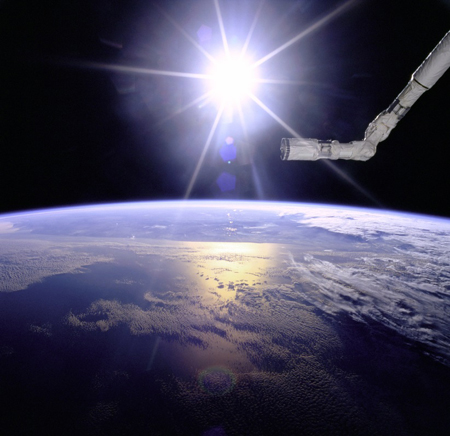Thirteen Ways of Looking at a Robotic Arm
By Dianne Timblin
An homage to the tireless, endlessly useful robotic arm. Patented in 1961 and first used in a GM manufacturing line, it has since been cast in countless roles. We’ve assembled a collection of videos intended to convey a broad cross-section of cultural touchpoints for this evolving technology.
February 16, 2015
Science Culture Communications Poetry
Research and investigation are almost synonymous terms, but the re of research is the significant element. In selecting the term research to express our ideal we were protesting against the supposition that a truth or a bit of knowledge is exhausted by having been once investigated and defined. . . . Not only does the world move but we the observers of the world move, and our landscape changes with each new position occupied. This fundamental principle of research we discover applies not only to scientific investigation but progress of all kinds. The spirit of research is not confined to the specialist in the laboratory.
—Henry Shaler Williams, in Sigma Xi Quarterly (now American Scientist), June 1913

Photograph by NASA (Great Images in NASA), via Wikimedia Commons
Hello, world! Welcome to Science Culture, a little corner of the Internet where you can expect to find musings on the ways that science and technology interact with other areas of learning, knowledge, and culture, as well as how STEM is represented in pop culture and entertainment. As Henry Shaler Williams observed back in 1913—in the second issue of our magazine, American Scientist—the world moves and our landscape changes, giving us unlimited opportunities to ponder and reexamine science not only in the laboratory but also in the world at large.
So, some days in Science Culture you’ll find reviews of science-related books, films, music, television, art, or museum exhibits. Other days we’ll discuss DIY projects, cuisine, science history, classics of science literature, or citizen science. Who knows what else the days may bring?
Today, we have something completely different: An homage to the tireless, endlessly useful robotic arm. Patented in 1961, its first appearance was on a GM manufacturing line in New Jersey. Since then, the robotic arm has been cast in countless roles. We’ve assembled a collection of videos, linked below, that, although merely scratching the surface of what this technology can do, is intended to convey a broad cross-section of cultural touchpoints. As you’ll see, this assembly of robotic arms interacts across a diverse array of fields: medicine, industry, space exploration, cuisine, entertainment, art, illustration, sport, fashion, theology, maker culture, and dance.
Oh, and it’s all wrapped up in a tribute to the poet Wallace Stevens. Because, why not?
Thirteen Ways of Looking at a Robotic Arm
(after "Thirteen Ways of Looking at a Blackbird," with apologies to Wallace Stevens)
I
Among a thousand busy robots,
one remains wild,
catapulting fire.
II
I was three hours
in line, to view robotic arms
spinning muscle cars.
III
The robot whirled, gave them no quarter
until lunch was no longer involved.
IV
A robotic arm and an elephant trunk
are one.
A robotic arm and a man and a ping-pong table
are one.
V
I do not know which to savor,
the expectation of food
or its consumption,
the presentation of a flavor
or the beauty of a sip.
VI
Planets filled a box
of projected light.
The shadow of the robot
swerved behind.
The magic trick:
A man escaped. Robots remain,
delicately chalked.
VII
O peckish ones,
why do you crave golden pancakes?
Do you not know
how the robots feast their sensors on you,
how they recreate your image?
VIII
I know fonts, the robot admits,
and insouciant, curled script;
but I know too
that sentience is uninvolved
in what I do.
IX
When the Ferrari consumed the freeway,
its driver traced
arcs through the air.
X
Presented with robots
flinging beams of green light,
dancers gave chase
in programmed symmetry.
XI
He orbited the Earth
in a metal coach,
a robot his footman.
Home, he mistook
the slender air beneath him
for waves.
XII
The reel is playing.
The robotic arm must be manufacturing.
XIII
Still, there was movement.
There was Curiosity
and curiosity.
Robots painted
as the woman spun.
American Scientist Comments and Discussion
To discuss our articles or comment on them, please share them and tag American Scientist on social media platforms. Here are links to our profiles on Twitter, Facebook, and LinkedIn.
If we re-share your post, we will moderate comments/discussion following our comments policy.